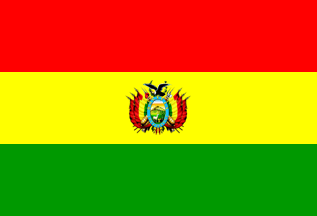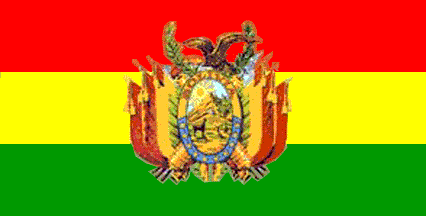TYPE: National flag.
USAGE:
RATIO: 15:22
ADOPTED: 31 October 1851
STATE FLAG:
NAVAL ENSIGN:

Last modified: 2016-04-30 by alex garofolo
Keywords: bolivia | buliwya | wuliwya | volívia | state flag | variation | fertility | bravery | wealth | president | flag: national | disc (blue) |
Links: FOTW homepage |
search |
disclaimer and copyright |
write us |
mirrors

TYPE: National flag.
USAGE:(du jure Civil Flag & Ensign; de facto Civil, State Flag & Ensign )
RATIO: 15:22
ADOPTED: 31 October 1851
STATE FLAG:
NAVAL ENSIGN:
The Bolivian tricolour was first hoisted in 1851 and is tierced in fess red, yellow, green. The colours are said to represent the bravery of the Bolivian soldiers, the nation's mineral wealth and the fertility of the land.
Alex Garofolo, 16 Jan 2015
Flag adopted on 31 October 1851 and confirmed on 14 July 1888, both by Presidential Decree.
Jaume Ollé, 01 Jan 1996
The most recent law on the Bolivian flag (Decreto Supremo Nº 27630) was published as a special issue of the official journal: Gaceta Oficial de Bolivia 2630/XLIV on 19 July 2004, La Paz. It shows a large color depiction of the national arms and the title Simbolos Patrios (= Symbols of the Fatherland). I’m not sure wheather these new regulations do indeed introduce any changes or just bring together and clarify previously disperse legal provisions and/or customary tradition.
António Martins-Tuválkin, 19 Aug 2005
The Bolivian flag is a vertical tricolour (tierced in fess) of red over yellow over green, as defined by Article V of the 1888 decree and Article 1 of the 2004 decree.
Alex Garofolo, 27 Jan 2015.
Article 3 of the 2004 decree gives the official pantone color shades: red is PMS 485 CVU, yellow is PMS Process Yellow, and green is PMS 356 CVU. Red and yellow match both the images on these pages and the illustrations in the law, but the shade of green not so: While the prescribed PMS value is darker than regular green (![]() ), the law text illustrations show a much brighter shade.
), the law text illustrations show a much brighter shade.
António Martins-Tuválkin, 19 Aug 2005.
The protocol manual for the London 2012 Olympics (Flags and Anthems Manual London 2012) provides recommendations for national flag designs. Each National Olympic Committe confirmed their colours with the London Game's Organization Committee. Bolivia's colours are defined as: PMS 485 red, process yellow, 356 green, 440 grey, process blue, 293 blue and black.
Ian Sumner, 10 Oct 2012
In Article 2 of the 2004 decree, the ratio of the flag is given as 7,5:11, which is as clumsy as it comes for a flag with three stripes of equal-height. A much more even fraction to express this ratio is 15:22. This pretty odd ratio seems to be a novelty, as all previous sources we heard of mentioned 2:3 instead (which is not very different from 15:22, anyway). The question is, as said, whether this ratio prescription indeed intends to introduce a change, or merely legislates what was previously unregulated…
António Martins-Tuválkin, 19 Aug 2005
The 15:22 ratio is slightly shorter than 2:3 (15 : 22.5).
Alex Garofolo, 06 Feb 2016
The official symbolism of the flag's colours was altered by the 2004 decree.
Alex Garofolo, 27 Jan 2015.
Article 1 of the 2004 decree gives the symbolism of the colors, as patriotic bloodshed, nature’s bounty, and verdure and hope.
António Martins, 19 Aug 2005
In Whitney Smith’s Flags through he Ages and Across the World [smi75b] the red is said to stand for the bravery of the Bolivian soldier, yellow represents the country’s mineral resources, and green is the fertility of the land.
Stephan Hurford, 13 Feb 2000.
According to Webster’s Concise Encyclopedia of Flags, 1985 [mch85a]: «The three horizontal stripes of the Bolivian flag — red, yellow and green — respectively symbolize the gallantry of Bolivian soldiers, the country’s mineral wealth, and the fertility of the land.».
Jarig Bakker, 13 Feb 2000

TYPE: State flag.
USAGE:(du jure State Flag & Ensign; de facto Presidential Standard)
RATIO: 15:22
ADOPTED: 31 October 1851
CONFIRMED: 14 July 1888 & 19 July 2004
Usage of the State Flag and War Flag is covered in Articles VI thru VII of the 1888 decree and in Article 4 of the 2004 decree.
Alex Garofolo, 27 Jan 2015.
The note beside the state flag in the Album 2000 [pay00] describes that it is also the personal flag for the President of the Republic and and that it is also used in 1:2 variant.
Željko Heimer, 11 Mar 2001.
The Bolivian coat of arms of 1888 are placed in the centre of the state flag.
Jarig Bakker, 02 Jan 2002
According to Article 6 of the 2004 decree, the proportion of the arms is 13 x 15 (and apparently occupying 13/17 the width of the central stripe). Plus, official Pantone colours of red 465, Process yellow, and green 356 (Article 7).
Christopher Southworth, 02 Aug 2004
I’ve been in Bolivia in March 2001; the state flag is hardly ever seen. Even over the presidential palace the plain tricolour is flown.
Mark Sensen, 03 Jul 2005

FIS:
According to an original piece received from the Bolivian Embassy in Paris (and a phone call from them), the flag should normally be in 2:3 ratio, the flag in 1:2 is a variant. My sources have various sizes of coat of arms on the flag.
Armand du Payrat, 28 Sep 1999, 12 Mar 2001.
View image on External Link:www.bolivian.com/bolivia/bandera.html.
Ralf Stelter, 13 Jun 1999.
.gif)
Flags and Arms across the World, by Whitney Smith[smi80], shows the coat of arms set on light blue disk of diameter equal to height of the yellow stripe.
Željko Heimer, 11 Mar 2001.
My sources, real flags and designs from French Embassy in La Paz and from Bolivian Embassy in Paris, do not concurr to a blue disk.
Armand du Payrat, 12 Mar 2001.
The coat of arms are described in Article I of the 1888 decree, and Article 5.IV of the 2004 decree. In 1888, the arms were described as being set on an «exterior field» of «pearl blue». In the 2004 decree, it is clarified that «when appropriate, the exterior field of the Shield shall be pearl blue». The imprecise wording of the 1888 decree may account for this variant / error.
António Martins, 19 Aug 2005.
The presidential decree of 7 August 1825 described the 1825 Coat of Arms. The current flag was promulgated by the decree of President Manuel Belzu in late 1851. The decree of 14 July 1888 described the Coat of Arms, and the flags for civil, state and military use. The 2004 decree described the same symbols as the 1888 document, but offered very detailed descriptions.
The full text of each decree can be read, in Spanish, on external links provided in the menu of this page.
The design is similar to the national flags of Ethiopia, Lithuania, Myanmar and Ghana. The same colour scheme is used by Grenada, Guyana, Vanuatu and 14 African nations.
Anything below this line was not added by the editor of this page.